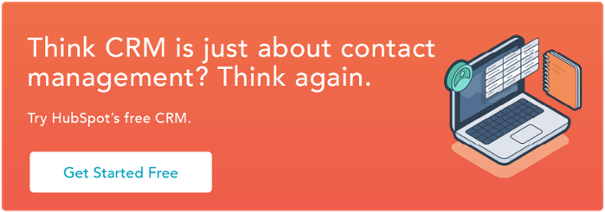As your business grows, manually keeping track of your prospects and customers with spreadsheets and random notes in different places becomes near impossible.
Not only is this type of system time- and energy-consuming to manage, but things also start slipping through the cracks at an alarming rate. This only serves to exhaust your team and disappoint to your customers.
You don't want this to happen to you, do you? No. That's why you need a CRM.
What does CRM stand for?
CRM stands for “customer relationship management.” A company’s CRM stores all interactions with potential and existing customers — everything from someone’s first visit to your website and activity on your website to the exact time they opened your sales proposal and how long they looked at it.
There are four main advantages of using a CRM.
Benefits of CRM
1. Better Customer Experience
It’s much easier to provide a positive buying experience when you know a lot about your prospect. Seeing at a single glance every blog post, email, and ebook they’ve opened and/or read, as well as key details like their company’s size, location, and vertical, gives you a major leg up.
You can personalize your messaging and provide more value from the start.
2. Higher Productivity
With a CRM, you can automate tasks like call and activity logging, reporting, deal creation, and more.
The less time reps are spending on administrative work, the greater number of hours they have to get in front of prospects. Your revenue will increase proportionally.
3. Increased Collaboration
A sales manager can instantly see how and when her salespeople are reaching out to and following up with buyers. An account executive (AE) can quickly fill himself in on an opportunity his sales development rep (SDR) has prospected and qualified for him.
Salespeople on the same team can learn more about each other’s best practices and pinch-hit for each other whenever someone goes on vacation or gets sick.
Essentially, a CRM boosts rep collaboration and efficiency.
4. Greater Insights
Stop wondering how your salespeople are doing. A CRM will give you both a high-level and on-the-ground picture of rep performance, including team-wide and individual conversion rates by deal stage, average deal size, deal velocity — and that’s just scratching the surface.
Imagine what you could do with this data-backed understanding of what’s working and what could be improved.
CRM Terms to Know
Before we dive into the nuts and bolts of using a CRM, you should be familiar with several key terms.
Contact
A contact is an individual person. Most CRMs will record their first and last name and email address. You can also keep track of details like their job title, company name, annual company revenue — the possibilities are nearly endless.
Lead
A lead has indicated an interest in your product. They might be a Marketing Qualified Lead (MQL), meaning they’ve somehow interacted with your marketing content (for instance, downloaded an ebook), or a Sales Qualified Lead (SQL), meaning your reps have identified them as a good fit.
Deal
Also known as an opportunity, a deal is a potential sale. A deal should move through the various stages of your sales process.
Link contacts to deals. If you’re working with CMO Jane Doe and Marketing Director John Smith on a single purchase, they should both be associated with that deal record.
Company
If you’re selling to businesses, you also want to keep track of which contacts and deals are linked to which organizations. The typical CRM puts the “company” record at the top of the hierarchy.
For example, you might associate 10 different contacts and three different deals to a single company.
Source
Your leads come from a variety of different sources. That might include trade shows, referrals, forms on your website, webinar attendees, etc. Keeping track of conversions by source and deals won by source lets you hone in on your most effective prospecting channels.
Activity
Any action by your salespeople or prospects typically falls under the activity umbrella, including calls, emails, voicemails, demos, a new contact record, an updated field, etc.
Deal Stage
Each step in your sales process should be represented by a deal stage. To give you an idea, your reps probably have an exploratory call with almost 100% of the prospects who buy.
So “exploratory call” might be the first deal stage in your CRM.
Pipeline
Deal stages are organized into pipelines. Every salesperson should have their own pipeline in the CRM so they can track which opportunities are currently in progress.
As a deal gets closer to the close, it should move from the left to the right.
CRM Strategy
A CRM strategy is how a company plans to use its CRM to grow its business and delight its customers. Generally, organizations will establish a CRM strategy before they start to use it.
Essentially, a CRM strategy keeps your organization focused on its goals. As we defined above, there are a lot of valuable tools and features that make up a CRM. But just because they're available doesn't mean they should be put to use just yet.
Many businesses stop using a CRM because they get overwhelmed. It's understandable but avoidable — if you create a CRM strategy upfront.
First, chat with your team to understand your goals. Sure, you want to better manage your customer relationships, but how? Why? What specific customer behaviors and interactions mean the most to your business? Jot these down as they will dictate how you'll fashion your CRM settings and reports.
Secondly, define your ideal customer(s), perhaps in the form of buyer personas. This information is not only valuable to Marketing and Sales, but it will also understand what types of customers should be added to your CRM down the line — and what types you shouldn't add.
Lastly, map your customer journey. How do your customer's typically "meet" your business? On average, how many touchpoints do customers needs before they subscribe to your newsletter, become a customer, and return for more? As your customer base grows and buyer personas split off into more detailed profiles, this customer journey will start to vary. Your CRM can help you keep track of that.
Now, let's dig into how to use your CRM.
How to Use a CRM
Once you've developed your CRM, it's time to put it to work.
1. Add your salespeople.
The sooner you can get all the reps on your team using your CRM, the more comprehensive and accurate your data will be.
That’s why the very first step in a CRM implementation should be adding users. But make sure you’ve explained the value of a CRM — specifically, how it will help your salespeople bring in more business — and gotten their buy in. If reps aren’t sold on the CRM, adoption will be extremely low.
(I recommend recruiting one of your top salespeople to act as an advocate. If she’s successfully using the CRM, her peers will naturally follow suit.)
2. Customize your settings.
Your CRM should reflect your sales process. That means it accurately maps to the stages a customer goes through from “lead,” to “opportunity,” to “customer.”
Of course, that requires knowing those stages in the first place. If you have no idea what your sales process looks like, take several weeks to observe and measure the way prospects buy your product or service.
What differentiates those who buy from those who opt for a competitor — or make no decision? How long does it take from initial contact with a salesperson to signed agreement, and what are the discrete steps in between?
Let’s say your sales process is divided into “Connect,” “Qualify,” “Demo,” and “Close.” Create deal stages in your CRM pipeline for each one. Now, you’ve standardized the sales process for your reps.
Next, create custom properties for store your data. Your CRM will have default “properties” or fill-in-the-blank details about your prospect. For example, HubSpot CRM comes with fields for phone number, email address, create date (the day they entered your system), city, and so on.
Most businesses have unique properties they want to track. To give you an idea, maybe you want to add a field for “Billing ID,” “Time zone,” “Product purchased,” or “Global office address.” Create those custom properties now before you import any existing data to your CRM.
Finally, if you’re using a different currency than your CRM’s pre-set currency, adjust that as well.
3. Import your contact, companies, and deals.
Chances are, you’re currently using a different CRM or spreadsheets to keep track of your prospects and opportunities.
Almost every CRM will let you bring in this information by uploading a CSV file. Each column in your spreadsheet should match a contact property in the CRM, so your data will flow seamlessly between your old and new systems.
4. Integrate your other tools.
Marketing, sales, and customer success information should be centralized in your CRM. This gives you a 360-view of your prospects and customers and cuts down on manual data entry.
Here’s an example of an inefficient process using several tools:
- Collect leads using a form builder →
- Put those leads into your email tool so Marketing can nurture them →
- Export qualified leads to your CRM
Imagine this process if you’re using the HubSpot CRM with HubSpot Marketing and Sales. Leads who filled out a form, started a conversation with a rep via chat, or performed key actions on your site will be added to your CRM. If they’re highly qualified, they can be routed to a salesperson. If the lead needs more time, the marketing team can nurture them with educational content. The entire process is seamless -- and far more efficient.
Not using HubSpot? I suggest picking tools that already integrate with your CRM of choice (check out your CRM’s integration partners) or connecting them using Zapier. For instance, you might set up a Zap so Google Form submissions are automatically transferred to your CRM.
5. Set up your dashboard.
You should have a crystal-clear overview of your team’s performance so you can keep them aligned and give the right coaching and direction. That’s why a CRM dashboard is so handy: It’s like a control panel that you can customize to fit your specific needs.
Choose which statistics appear on your dashboard based on your sales objectives and process. For instance, if your team is supposed to sell more of X product this month, you might want to see a breakdown of units of X product sold versus Y product. Or if you set activity metrics for your reps, you may want to have a section for the day’s “completed activities.”
6. Enable reports.
As a sales manager, you’re spending a lot of time looking at data. But your reps should be spending as much time as possible selling. That’s why it’s a great idea to create daily, weekly, monthly, and/or quarterly email reports.
For instance, reps at HubSpot receive a stack ranking each morning via email showing how each member of the team is doing that month: New business, upsell and cross-sell revenue, and net revenue. This daily digest encourages friendly competition and gives salespeople an incentive to keep working even after they’ve hit quota.
Consider sending out an email for activities added and/or completed by rep, emails sent and/or received by rep, calls made by rep, deals won by rep (displayed by count or value), and/or retention rate by rep.
Your CRM Is the Key
This guide is only scratching the surface of what you can accomplish with a CRM. And the sooner you get started, the better — it’s really never too early to use a CRM.
Editor's note: This post was originally published in September 2017 and has been updated for comprehensiveness.






